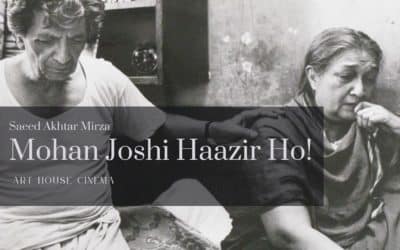Neecha Nagar, released in 1946 is a Hindi film directed by Chetan Anand. This film is considered one of the pioneering efforts in the field of expressionist social realism in Indian Cinema. Written by Khwaja Ahmad Abbas, this film is inspired by Maxim Gorky’s Lower Depths. The film was financed by the Indian People’s Theater Association (IPTA).
Cast
- Kamini Kaushal
- Uma Anand
- Zohra Sehgal
- Rafiq Ahmad
The Story
The story of Neecha Nagar revolves around a wealthy landlord ‘Sarkar’ who lives in a palatial estate on the top of a mountain while his poor serfs toil hard and live a life full of misery and starvation in the villages in the valley below. The villagers’ loathing towards the landlord is augmented by the fact that the sewer from the landlord’s palace dumps the waste directly in their village, spreading diseases and death. The tyrant diverts the water supply of the village to make profits and there is not a drop to drink. It is then that the protagonists learn about Sarkar’s true intention, to drive them away so that he can use their land for his construction project. They send a delegation to Sarkar to request him to move the drain away but he comes up with his own logic that it is not sewage but a canal and it is for their own good that he has diverted it to Neecha Nagar, to irrigate their fields and provide water for their cattle.
However they reason, Sarkar is not willing to listen, more so because he controls everything. He even manages to get a few henchmen in Neecha Nagar. The muck flows into the settlement and people start falling sick. When the people send another delegation, Sarkar pacifies them with a sugarcoated philanthropic proposal that he will make a hospital for the sick. The people of this God-Forsaken settlement are destined to a hopeless destiny…
Observation
Neecha Nagar is a simple film which says as much about an age-old issue that it could manage in pre-Independent India. It is a poetic portrayal of destitution and deprivation of rural India and highlights the exploitation of the poor peasants by the aristocracy. Deeply influenced by the ideas of Socialism, the film has a universal appeal which is evident in the warm reception it got in the Cannes’ Festival. Chetan Anand’s treatment of the subject and the cinematography are the highlights of this film. Some frames are such that they remain etched for a long time in the mind of the viewer – like a boy whose throat is parched with thirst, he bends over a cesspool, hesitates and then drinks the foul water anyway.
Credit also must go to the writer of the film, Khwaja Ahmad Abbas who manages to weave an intricate tale of social disparity, exploitation and humanism in the middle of all the suffering. The script is linear and crisp and never for a moment, does it wander from its goal – to make a hard-hitting point with soft subtlety.
The music of the film is noteworthy for its lyrics as much as for the fact that it happens to be the first film of Pandit Ravi Shankar as a Music Director. Two of the songs are revolutionary battle cries and it is surprising how the British authorities allowed them uncut.
Reception
Owing to its revolutionary and socialist character, the film was never released commercially. However, it made an entry to the Cannes Film festival and managed to win the Grand Prix prize. Till date, it is considered one of the classics of Indian cinema.
Trivia
- Neecha Nagar happens to be the debut film of Chetan Anand, Pandit Ravi Shankar and actress Kamini Kaushal.
- When Neecha Nagar was sent to Cannes, it was one song less and no dance.







Been a while hasn’t it Puru since you did one of these – or have I missed some? You evoke interest in me in a movie that I’d not even consider since I hate being depressed :)
Yup, this was the first post on this blog .. about the film, it can be a bit depressing, you might consider watching them just as a form of art.
Thank you very much for introducing this movie. I have watched some of Ritwik Ghatak, Mrinal sen and Satyajit Ray’s movies, but mostly it’s great challenge to attain the Dvd’s of these movies. “Neecha Nagar” — I have never heard about this film, considering it has won a Grand Prix at Cannes. Will now keenly follow your posts to know more about the Indian artistic movie ventures.
Thank You Arun. I have been inspired from your blog, where you give such a wonderful account of World cinema. So I started this project to bring the films of the Indian Cinema to light. Slowly over the years, it will become a good repository dedicated to Art House Cinema of India.
Most of the films are on You Tube now (Iegal). Those which are not, I will find out where their prints can be taken from. Just imagine, most of us do not even know the first Grand Prix winner from India, the efforts of those forgotten filmmakers needs to be given justice.
Thanks again for the encouraging words. It means a lot :)
should watch it
A really gr8 film by Chetan Anand. A must watch for art cinema lovers
Belated thanks for coming on Art House Cinema SK Sinha ji